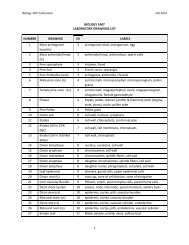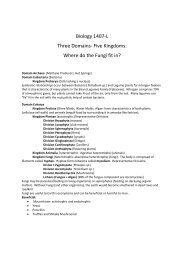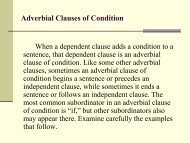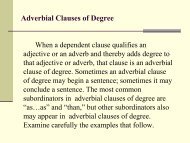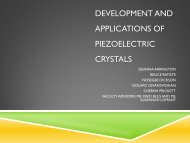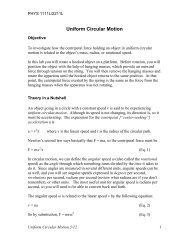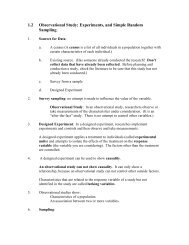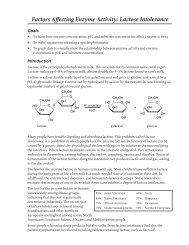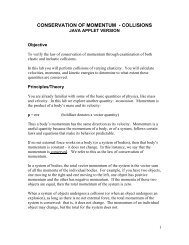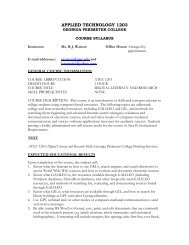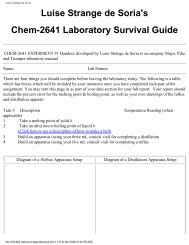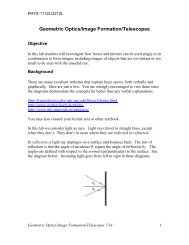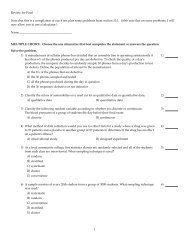CHAPTER TWENTY-FOUR TECHNOLOGY, R&D, AND EFFICIENCY
CHAPTER TWENTY-FOUR TECHNOLOGY, R&D, AND EFFICIENCY
CHAPTER TWENTY-FOUR TECHNOLOGY, R&D, AND EFFICIENCY
You also want an ePaper? Increase the reach of your titles
YUMPU automatically turns print PDFs into web optimized ePapers that Google loves.
Technology, R&D, and Efficiency<br />
<strong>CHAPTER</strong> <strong>TWENTY</strong>-<strong>FOUR</strong><br />
<strong>TECHNOLOGY</strong>, R&D, <strong>AND</strong> <strong>EFFICIENCY</strong><br />
I. Learning objectives – In this chapter students will learn:<br />
A. The differences between an invention, an innovation, and technological diffusion.<br />
B. How entrepreneurs and other innovators further technological advance.<br />
C. How a firm determines its optimal amount of research and development (R&D).<br />
D. Why firms can benefit from their innovation even though rivals have an incentive to imitate<br />
it.<br />
E. About the role of market structure in promoting technological advance.<br />
F. How technological advance enhances productive and allocative efficiency.<br />
II. Technological Advance: Invention, innovation and diffusion.<br />
A. In the short run it is assumed that technology, plant, and equipment are constant. In the long<br />
run, the size of the plant can change and firms can enter or leave the industry; in the very long<br />
run, technological advances can occur.<br />
B. Technological advance is a three-step process that shifts the economy’s production<br />
possibilities curve outward-enabling more production of goods and services.<br />
1. The most basic element of technological advance is invention: The discovery of a<br />
product or process and the proof that it will work.<br />
2. Innovation is the first successful commercial introduction of a new product, the first use<br />
of a new production, or the creation of a new form of business enterprise.<br />
3. Diffusion is the spread of innovation through imitation or copying.<br />
C. Expenditures on research and development include direct efforts by business toward<br />
invention, innovation and diffusion. Government also engages in R&D, particularly for<br />
national defense.<br />
1. In 2004 total U.S. R&D expenditures (business plus government) were $312 billion, 2.66<br />
percent of U.S. GDP. (See Global Perspective 24.1 for comparison.)<br />
2. American business spent $200 billion on R&D in 2004. (See Figure 24.1 for breakdown<br />
into categories.)<br />
D. The modern view of technological advance.<br />
1. For decades economists treated technological advances as an element largely external to<br />
the market system — a random outside force to which the economy adjusted.<br />
2. Contemporary economists see capitalism itself as the driving force of technological<br />
advance, providing the incentives and motives for firms and individuals to seek profitable<br />
opportunities.<br />
III. The role of entrepreneurs and other innovators.<br />
A. The entrepreneur is an initiator, innovator, and risk bearer—the catalyst who uses resources<br />
in new and unique ways to produce new and unique goods and services.<br />
B. Other innovators, who do not bear personal financial risk, include key executives, scientists,<br />
and others engaged in commercial R&D activities.<br />
365
Technology, R&D, and Efficiency<br />
C. Often entrepreneurs form new companies called “start-ups”, i.e., firms that focus on creating<br />
and introducing new products or employing a specific new production or distribution<br />
technique.<br />
D. Innovators are also found within existing corporations supported by working conditions and<br />
pay incentives that foster creative thinking. Some firms have chosen to “spin off” the R&D<br />
function into new, more flexible and innovative companies.<br />
E. Product innovation and development are creative endeavors with intangible rewards of<br />
personal satisfaction, but the “winners” can also realize huge financial gains. Success gives<br />
entrepreneurs and innovative firms access to more resources. The entrepreneurs are found in<br />
many different countries around the world.<br />
F. Technological advance is supported by the scientific research of universities and government<br />
sponsored laboratories. Firms increasingly help to fund university research that relates to<br />
their products.<br />
IV. The firm’s optimal amount of R&D.<br />
A. Finding the optimal amount of R&D is an application of basic economics.<br />
1. To earn the greatest profit, a firm should expand a particular activity until its marginal<br />
benefit equals its marginal cost.<br />
2. The R&D spending decision is complex because the estimation of future benefits is<br />
highly uncertain while costs are immediate and more clear-cut.<br />
B. Interest rate cost of funds: Whatever the source of R&D funds, the opportunity cost of these<br />
funds is measurable by the current rate of interest. (See Figure 24.2) Possible sources include<br />
the following:<br />
1. Bank loans<br />
2. Bonds<br />
3. Retained earnings<br />
4. Venture capital<br />
5. Personal savings<br />
C. A firm’s marginal benefit from R&D is its expected rate of return on the expenditures. The<br />
curve showing the expected rate of return slopes downward because of diminishing returns to<br />
R&D expenditures. (See Figure 24.3)<br />
D. Optimal R&D expenditures occur when the interest rate cost of funds is equal to the expected<br />
rate of return. (See Figure 24.4)<br />
1. Many R&D expenditures may be affordable but not worthwhile because the marginal<br />
benefit is less than the marginal cost.<br />
2. Expenditures are planned on the basis of expected returns. R&D decisions carry a great<br />
deal of risk. There is no certainty of outcome.<br />
V. Increased profit via innovation.<br />
A. Increased profit via product innovation.<br />
1. Consumers will buy a new product only if it increases the total utility they obtain from<br />
their limited incomes. They purchase products that have the highest marginal utility per<br />
dollar. (Review Chapter 19 and Table 19.1)<br />
a. Consumer acceptance of a new product depends on both marginal utility and price.<br />
366
Technology, R&D, and Efficiency<br />
VI.<br />
b. The expected return that motivates product innovation may not be realized.<br />
Expensive ‘“flops” are common.<br />
c. Most product innovation consists of incremental improvements to existing products<br />
rather than radical inventions.<br />
B. Reduced cost via process innovation.<br />
1. Firms can increase output by introducing better production methods or by using more<br />
productive capital equipment.<br />
2. An innovation that increases total product at each level of resource usage lowers the<br />
average total cost of a unit of output and thus enhances the firm’s profit. (Figure 24.5)<br />
Imitation and R&D Incentives<br />
A. A firm’s rivals may deliberately employ the “fast-second strategy,” allowing the originating<br />
firm to incur the high costs of R&D and then entering quickly if the product is a success.<br />
B. There are protections, potential advantages, and benefits of being first.<br />
1. Some technological breakthroughs can be patented; they cannot be legally imitated for<br />
two decades. (See global perspective 24.2) Many holders of U.S. patents are citizens or<br />
firms of foreign nations.<br />
2. Copyrights and trademarks reduce the problem of direct copying. (See Concept<br />
Illustration on Monopoly game)<br />
3. Along with trademark protection, brand name recognition may give the original<br />
innovator a marketing advantage.<br />
4. Trade secrets may prevent imitation of a product, and sometimes it is the process that is<br />
the key to success. The originating firm may also gain an advantage simply by learning<br />
on the job. Consider This … Trade Secrets<br />
5. Time lags between innovation and diffusion often permit originating firms to realize a<br />
substantial economic profit.<br />
6. A final advantage of being first is the potential for an attractive buyout offer. This allows<br />
the innovative entrepreneur to take their rewards immediately without the uncertainty of<br />
production and marketing on their own.<br />
7. There continue to be high levels of R&D that would not be the case if imitation<br />
consistently and severely depressed actual rates of return on these expenditures. (See<br />
Figure 24.6)<br />
VII.<br />
Role of Market Structure<br />
A. Market structure and technological advance.<br />
1. Pure competition—Although purely competitive firms may have an incentive to keep<br />
ahead of their competitors, the small size of the firms and the fact that there are no<br />
barriers to entry and therefore they can earn only a normal profit in the long run, leads to<br />
serious questions as to whether such producers can benefit from and finance substantial<br />
R&D programs.<br />
2. Monopolistic competition—There is a strong profit incentive to engage in product<br />
development in this market structure. However, most firms remain small, which limits<br />
367
Technology, R&D, and Efficiency<br />
their ability to secure financing for R&D. Economic profits are usually temporary<br />
because there are few barriers to entry.<br />
3. Oligopoly—The oligopolistic market structure is conducive to technical advance. Firms<br />
are large with ongoing economic profits, are protected by barriers to entry, and have large<br />
volume of sales. Although oligopolistic firms have the financial resources to engage in<br />
R&D, they are often complacent.<br />
4. Pure monopoly—Pure monopolists have little incentive to engage in R&D. Since profits<br />
are protected by absolute barriers to entry, the only reason for R&D would be defensive,<br />
i.e., to reduce the risk of a new product or process that might destroy the monopoly.<br />
B. Inverted-U Theory (Figure 24.7)<br />
1. The inverted-U suggests that both very low concentration industries and very high<br />
concentration industries expend a relatively small percentage of their sales revenue on<br />
R&D.<br />
2. The optimal market structure for technological advance seems to be an industry in which<br />
there is a mix of large oligopolistic firms (a 40 to 60 percent concentration ratio) with<br />
several highly innovative smaller firms.<br />
3. Competitive firms are small, which makes it difficult for them to finance the R&D, and<br />
there is easy entry by competitors. Where firms have a substantial amount of monopoly<br />
power, monopoly profits are large and innovation will likely not add much more to the<br />
firm’s profits.<br />
4. The level of R&D spending within an industry seems to be determined more by the<br />
industry’s scientific character and “technological opportunities” than from its market<br />
structure.<br />
VIII.<br />
IX.<br />
Technological Advance and Efficiency<br />
A. Productive efficiency is improved when a technological advance involves process innovation<br />
and a reduction in costs. (Figure 24.5a and b)<br />
B. Allocative efficiency is improved when a technological advance involves a new product that<br />
increases the utility consumers can obtain from their limited income.<br />
C. Innovation can create monopoly power through patents or the advantages of being first,<br />
reducing the benefit to society from the innovation.<br />
D. Innovation can also reduce or even disintegrate existing monopoly power by providing<br />
competition where there was none. In this case, economic efficiency is enhanced because the<br />
competition drives prices down closer to marginal cost and minimum ATC.<br />
E. Creative destruction occurs when the innovation of new products or production methods<br />
destroys the monopoly positions of firms committed to existing products and their old ways<br />
of doing business.<br />
LAST WORD: On the Path to the Personal Computer and Internet<br />
Technological advance is clearly evident in the development of the modern personal computer<br />
and the emergence of the Internet. This is a brief history of these events.<br />
ANSWERS TO END-OF-<strong>CHAPTER</strong> QUESTIONS<br />
24-1 What is meant by technological advance, as broadly defined How does technological advance<br />
enter into the definition of the very long run Which of the following are examples of<br />
technological advance, and which are not: an improved production process; entry of a firm into a<br />
368
Technology, R&D, and Efficiency<br />
profitable purely competitive industry; the imitation of a new production process by another firm;<br />
an increase in a firm’s advertising expenditures<br />
Technological advance is broadly defined as new and better goods and services and new and<br />
better ways of producing or distributing them. There is a distinction between the “long run” and<br />
the very “long run”: In the long run, technology is constant but firms can change their plant sizes<br />
and are free to enter or exit industries. In contrast, the very long run is a period in which<br />
technology can change and in which firms can introduce entirely new products.<br />
(a) An improved production process; Yes (innovation)<br />
(b) Entry of a firm into a profitable purely competitive industry; No<br />
(c) The imitation of a new production process by another firm; Yes (Diffusion)<br />
(d) An increase in a firms advertising expenditures; No<br />
24-2 Listed below are several possible actions by firms. Write “INV” beside those that reflect<br />
invention, “INN” beside those that reflect innovation, and “DIF” beside those that reflect<br />
diffusion.<br />
a. An auto manufacturer adds “heated seats” as a standard feature in its luxury cars to keep pace<br />
with a rival firm whose luxury cars already have this feature.<br />
b. A television production company pioneers the first music video channel.<br />
c. A firm develops and patents a working model of a self-erasing whiteboard for classrooms.<br />
d. A lightbulb firm is the first to produce and market lighting fixtures with halogen lamps.<br />
e. A rival toy maker introduces a new Jenny doll to complete with Mattel’s Barbie doll.<br />
(a) DIF<br />
(b) INN<br />
(c) INV<br />
(d) INN<br />
(e) DIF<br />
24-3 Contrast the older and modern views of technological advance as they relate to the economy.<br />
What is the role of entrepreneurs and other innovators in technological advance How does<br />
research by universities and government affect innovators and technological advance Why do<br />
you think some university researchers are increasingly becoming more like entrepreneurs and less<br />
like “pure scientists”<br />
The older view of technological advance was that it was external to the economy; a random<br />
outside force to which the economy adjusted. Scientific and technological advances were<br />
fortuitous and helpful but largely external to the market system. Most contemporary economists<br />
have a different view. They see capitalism itself as the driving force of technological advance. In<br />
this view, invention, innovation, and diffusion occur in response to incentives provided by the<br />
market. The motivation to seek new products and processes is driven by the expectation of new<br />
profit opportunities.<br />
An entrepreneur is an initiator, innovator, and risk bearer—the catalyst who combines, land, labor<br />
and capital resources in new and unique ways to produce new goods and services. Historically,<br />
these were individuals. In today’s more technologically complex economy, this role is just as<br />
likely to be carried out by entrepreneurial teams. Unlike entrepreneurs, other innovators do not<br />
bear personal financial risk. These people include key executives, scientists, and other salaried<br />
employees engaged in commercial R&D activities.<br />
369
Technology, R&D, and Efficiency<br />
New scientific knowledge is highly important to technological advance, but scientific principles,<br />
as such, cannot be patented. For this reason entrepreneurs actively study the scientific output of<br />
university and government laboratories to find discoveries with commercial applications,<br />
obtaining information without paying for its development. Although, firms increasingly help<br />
fund university research that relates to their products, scientists increasingly realize their work<br />
may have commercial value.<br />
24-4 (Key Question) Suppose a firm expects that a $20 million expenditure on R&D will result in a<br />
new product that will increase its revenue by a total of $30 million 1 year from now. The firm<br />
estimates that the production cost of the new product will be $29 million.<br />
a. What is the expected rate of return on this R&D expenditure<br />
b. Suppose the firm can get a bank loan at 6 percent interest to finance its $20 million R&D<br />
project. Will the firm undertake the project Explain why or why not.<br />
c. Now suppose the interest-rate cost of borrowing, in effect, falls to 4 percent because the firm<br />
decides to use its own retained earnings to finance the R&D. Will this lower interest rate<br />
change the firm’s R&D decision Explain.<br />
(a) 5 percent;<br />
(b) No, because the 5 percent rate of return is less than the 6 percent interest rate;<br />
(c) Yes, because the 5 percent the rate of return is now greater than the 4 percent interest rate.<br />
24-5 (Key Question) Answer the following lettered questions on the basis of the information in this<br />
table:<br />
Amount of<br />
R&D,<br />
millions<br />
$10<br />
20<br />
30<br />
40<br />
50<br />
60<br />
Expected rate<br />
of return on R&D,<br />
%<br />
16<br />
14<br />
12<br />
10<br />
8<br />
6<br />
a. If the interest-rate cost of funds is 8 percent, what will be the optimal amount of R&D<br />
spending for this firm<br />
b. Explain why $20 million of R&D spending will not be optimal.<br />
c. Why won’t $60 million be optimal either<br />
(a) $50 million, where the interest-rate cost of funds (i) equals the expected rate of return (r);<br />
(b) at $20 million in R&D, r of 14 percent exceeds i of 8 percent, thus there would be an<br />
underallocation of R&D funds;<br />
(c) at $60 million, r of 6 percent is less than i of 8 percent, thus there would be an overallocation<br />
of R&D funds.<br />
24-6 (Key Question) Refer to Table 24.1 and suppose the price of new product C is $2 instead of $4.<br />
How does this affect the optimal combination of products A, B, and C for the person represented<br />
370
Technology, R&D, and Efficiency<br />
by the data Explain: “The success of a new product depends not only on its marginal utility but<br />
also on its price.”<br />
(a) The person would now buy 5 units of product C and zero units of A and B;<br />
(b) The MU/price ratio is what counts; a new product can be successful by having a high MU, a<br />
low price, or both relative to existing products.<br />
24-7 Learning how to use software takes time. So once customers have learned to use a particular<br />
software package, it is easier to sell them software upgrades than to convince them to switch to<br />
new software. What implications does this have for expected rates of return on R&D spending<br />
for software firms developing upgrades versus those developing imitative products<br />
Expenditures on R&D carry a great deal of risk. Upgrading an existing product is likely to be<br />
less risky than developing an imitated product. Consumers value their time as well as money and<br />
are likely to prefer products that are familiar.<br />
Imitating a successful product may save the cost of R&D for development, but there are<br />
significant protections that may end up costing the “copy cat” firm dearly. Patents, copyrights<br />
and brand name recognition all contribute to give the original innovator a major marketing<br />
advantage.<br />
24-8 (Key Question) Answer the following questions on the basis of this information for a single firm:<br />
total cost of capital = $1,000; price paid for labor = $12 per labor unit; price paid for raw<br />
materials = $4 per raw-material unit.<br />
a. Suppose the firm can produce 5,000 units of output by combining its fixed capital with 100<br />
units of labor and 450 units of raw materials. What are the total cost and average total cost of<br />
producing the 5,000 units of output<br />
b. Now assume the firm improves its production process so that it can produce 6,000 units of<br />
output by combining its fixed capital with 100 units of labor and 450 units of raw materials.<br />
What are the total cost and average cost of producing the 6,000 units of output<br />
c. Refer to your answers to 8a and 8b and explain how process innovation can improve<br />
economic efficiency.<br />
(a) Total cost = $4,000; average total cost = $.80 (= $4,000/5,000 units);<br />
(b) Total cost = $4,000, average total cost = $.667 (= $4,000/6,000 units);<br />
(c) Process innovation can lower the average total cost of producing a particular output, meaning<br />
that society uses fewer resources to produce a given amount of output. Resources are freed<br />
from this production to produce more of other desirable goods. Society realizes extra output<br />
through a gain in efficiency.<br />
24-9 Why might a firm making a large economic profit from its existing product employ a fast-second<br />
strategy in relationship to new or improved products What risks does it run in pursuing this<br />
strategy What incentive does a firm have to engage in R&D when rivals can imitate its new<br />
products<br />
A dominant firm that is making large profits from its existing products may let smaller firms in<br />
the industry incur the high costs of product innovation while it closely monitors their successes<br />
and failures. In using this “fast, second strategy,” the dominant firm counts on its own product<br />
improvement abilities, marketing prowess, or economies of scale to prevail.<br />
A firm that attempts to imitate the new products of rival firms may encounter a variety of<br />
roadblocks. Patent rights for a secret process may stop the effort cold or lead to costly lawsuits.<br />
Developing new products can be very profitable and there are several protections, and advantages<br />
to taking the lead including: patent protection, copyrights and trademarks, lasting brand name<br />
371
Technology, R&D, and Efficiency<br />
recognition, benefits from trade secrets and learning by doing, high economic profits during the<br />
lag time between a products introduction and its imitation, and the possibility of lucrative buyout<br />
offers from larger firms’.<br />
24-10 Do you think the overall level of R&D would increase or decrease over the next 20 to 30 years if<br />
the lengths of new patents were extended from 20 years to, say, “forever” What if the duration<br />
were reduced from 20 years to, say, 3 years<br />
If patent rights were extended indefinitely the motivation to spend on R&D could increase for<br />
two reasons. First the extended patent rights would add to their potential value and second,<br />
perpetual patent rights would provide an additional incentive to find a way around these rights.<br />
Firms would be motivated to seek other products and processes not covered by the endless patent<br />
restrictions.<br />
If the restriction were reduced to a much shorter period of three years, the spending on R&D<br />
would be likely to decrease. The short period of protection would make it difficult to recover the<br />
costs of development.<br />
24-11 Make a case that neither pure competition nor pure monopoly is very conducive to a great deal of<br />
R&D spending and innovation. Why might oligopoly be more favorable to R&D spending and<br />
innovation than either pure competition or pure monopoly What is the inverse-U theory and<br />
how does it relate to your answers to these questions<br />
For a purely competitive firm, the expected rate of return on R&D may be low or even negative.<br />
Because of easy entry, its profit rewards from innovation may quickly be competed away by<br />
existing or entering firms that also produce the new product or adopt the new technology. The<br />
small size of the firm would make it difficult to finance the R&D as well.<br />
The pure monopoly market structure may provide the least incentive to engage in R&D.<br />
Absolute barriers prevent competition. The only incentive for R&D expenditures would be<br />
defensive, to reduce the risk of some new product or process that could destroy the monopoly.<br />
The oligopoly market structure has many characteristics that are conducive to technological<br />
advance. First, the large size enables them to finance the often very expensive R&D costs<br />
associated with major product or process innovation. The typical firm in oligopoly is likely to<br />
realize ongoing economic profits, which provides a ready source of funds. The existence of<br />
barriers to entry gives some assurance that any economic profits earned from innovation can be<br />
maintained. The large volume of sales allows the firm to spread the cost of R&D over a great<br />
many units of output. The large size of the firms in oligopoly also makes it easier to absorb the<br />
inevitable losses from “misses” while waiting for compensation from the “hits.”<br />
The inverted-U theory suggests that R&D expenditures as a percentage of sales rise with industry<br />
concentration until the four-firm concentration ratio reaches about 50%. Further increases in<br />
industry concentrations are associated with lower relative R&D expenditures. (See figure 26-8)<br />
The inverted-U theory reiterates the assessment made above regarding likely R&D spending and<br />
market structure.<br />
24-12 Evaluate: “Society does not need laws outlawing monopolization and monopoly. Inevitably,<br />
monopoly causes its own self-destruction, since its high profit is the lure for other firms or<br />
entrepreneurs to develop substitute products.”<br />
Innovation can reduce or even disintegrate existing monopoly power by producing competition<br />
where there was none. According to Schumpeter, a new innovator will automatically displace<br />
any monopolist that no longer delivers superior performance. But many contemporary<br />
economists think this view reflects more wishful thinking than fact. Dominant firms have been<br />
known to persuade government to give them tax breaks, subsidies, and tariff protection to<br />
strengthen their market power. While innovation in general enhances economic efficiency, in<br />
some cases it can lead to entrenched monopoly power. Further innovation may eventually<br />
372
Technology, R&D, and Efficiency<br />
destroy this monopoly power, but the process of creative destruction is neither automatic nor<br />
inevitable.<br />
24-13 (Last Word) Identify a specific example of each of the following in this Last Word:<br />
a. entrepreneurship,<br />
b. invention,<br />
c. innovation, and<br />
d. diffusion.<br />
(a) 1985- Ted Waitt starts a mail-order personal computer business (Gateway 2000) in his South<br />
Dakota barn.<br />
(b) 1947- AT&T scientists invent the “transfer resistance device” later known as the transistor. It<br />
replaces the less reliable vacuum tubes in computers.<br />
(c) 1981- Logitech commercializes the “x-y position indicator for a display system.” Invented<br />
earlier by Douglas Engelbart in a government funded research lab. Someone dubs it a<br />
“computer mouse” because it appears to have a tail.<br />
(d) 1982 Compaq Computer “clones” the IBM machines; others do the same. Eventually<br />
Compaq becomes the leading seller of personal computers.<br />
373



